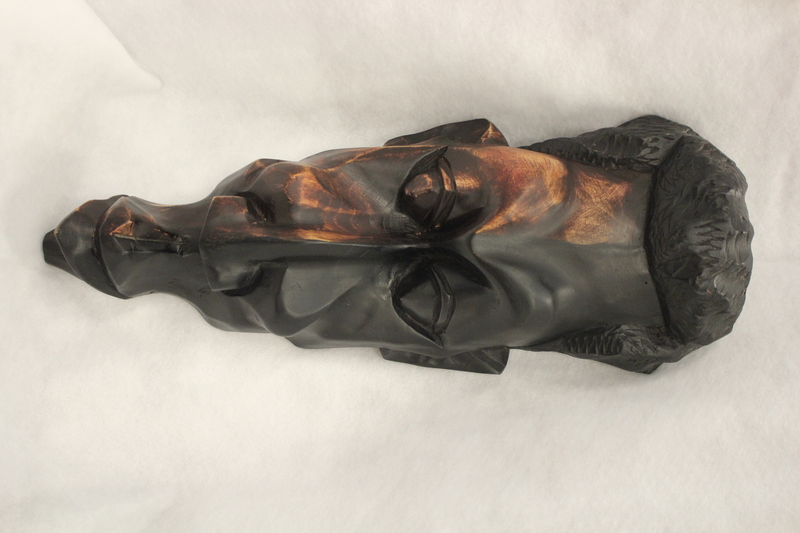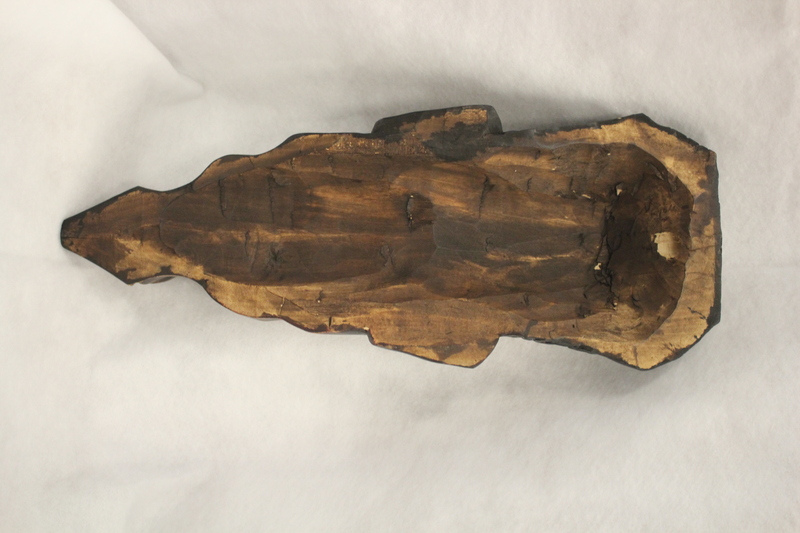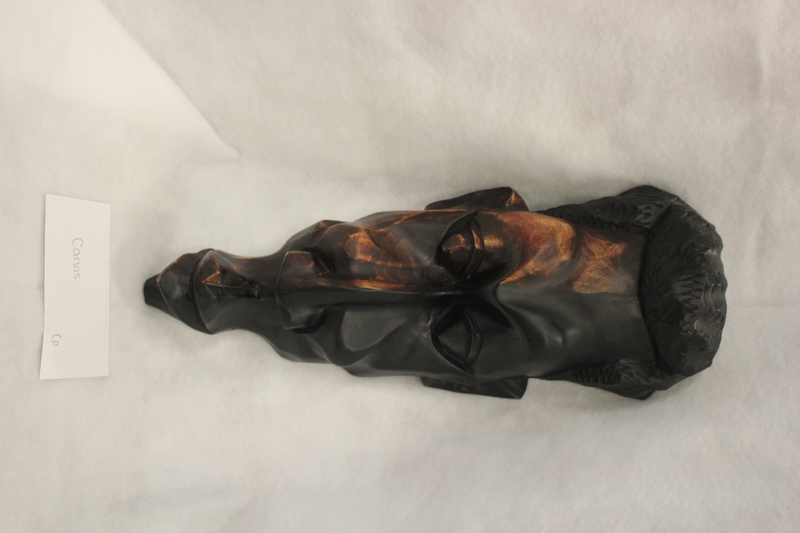African Face Mask
Title
African Face Mask
Subject
Art, Ghanian
Afro-Latin Americans
Culture in art
Racially mixed people—Latin America
Race relations
Afro-Latin Americans
Culture in art
Racially mixed people—Latin America
Race relations
Description
Contributor Carlos Soler brought in an African Face Mask for the Harvest, which he purchased in a wood carving village in Ghana when he was studying abroad about twenty years ago. When he saw the mask, he knew he had to have it. He feels strongly that the mask personifies him in a variety of ways. Carlos saw in the black painted wood carving distinct facial features such as the wave of the hair, the high, strong cheek bones. He recognized these characteristics as his own. Carlos, like much of the Latino population in the United States is of a mixed racial background. He describes that he is of European, African and Puerto Rican decent. Half of the black wooden mask looks to be worn, or lightly sanded, to expose the unpainted wood below. Carlos states that it was made like that, purposely, to represent the lighter skin tones of mixed race peoples. It is an unfortunate fact, but one that hold true at times, even within the Latino community, “if a Puerto Rican is dark-skinned or black, (s)he tends to experience more discrimination than one who is light-skinned or white.”
Carlos was born and raised in Hartford and New Britain, Connecticut, spending three years back in Puerto Rico where his parents moved from in 1973. Growing up, Carlos never saw or embraced himself as Black or of mixed ethnic heritage. Carlos identified himself solely as Latino, though known, it was hard to think otherwise. He describes how at the time, “Black or of mixed ethnicity seemed other, ‘over there.’ It was not a part of him.” Speaking very articulately and from years of education, Carlos openly shares some of his views from youth. The idea that being Black was associated with being bad, poor or uneducated, he felt this was pushed upon him by acculturation, the media, T.V. and the news of the time. Unlike the views of greatness and beauty that he holds and teaches about being of Black and mixed heritage today, back when he was young, it wasn’t exactly so. Many immigrants of Latino and mixed ethnicity go through similar struggles with identity. “Puerto Rican Artist Bibiana Suarez questions the contradictory images of herself held by her home and host countries through two self –portraits, one in which she is black and another in which she is white. The message is unmistakable: the dominate society in the United States views immigrants from the Caribbean as non-white, while on the island her blond hair and green eyes make her blanquito.” We can see through Carlos’ experience, though viewed as non-white, Latinos are not seen as Black either.
Carlos is open about how “he and his friends, from the Grant Street neighborhood, predominantly Latino, would have ‘Beef’ with the kids from the Mount Pleasant neighborhood, which was predominantly Black. They, each side, manifested anger and hatred based on skin color. He thinks now, how neither side really did anything constructive to help out each other’s’cause.”
In many instances, such as part of the Race Riots of East Los Angeles in 1992, there is seen a competition between Blacks and Latino Immigrants struggling for economic position and there is nothing clear or direct about the competition.” “When unemployed Blacks see jobs going to Latinos who are newly arrived, who may speak little English, and who may not even be in the country legally, they naturally feel resentful. That resentment may grow into something much uglier and more powerful when Blacks suspect that Latinos are being used as instruments of white racism and that newcomers are getting jobs, not because they are better workers, but because they are not Blacks.”
It was through his college education, the process of learning, and of travel that helped Carlos to explore thoughts about identity and to dive deep into the blend of his culture. When schooling in Ghana, Carlos noticed many aspects of life, culture, and food that were similar to his identified Puerto Rican culture. He explains that this was all a process, and that it took some time to rethink everything, his culture, his identity. There was a time that he hated himself for feeling and acting the way he had.
Carlos now embraces, celebrates and shares his mixed ethnicity. He is very comfortable in sharing his experiences and views with others, and you can tell that they emanate from a deep sense of love and pride. He teaches what he has experienced and shares openly with others. His immediate family is very supportive of his views about his identity, though others may not be able to verbalize of embrace their richness quite as fully at this time. Currently, Carlos’s face mask occupies a prominent place in his kitchen, displaying one lighter and one darker side of the same façade. It is a proud piece of discussion and conversation. Carlos strikes those he meets as happy and at peace with himself and his identity.
Carlos was born and raised in Hartford and New Britain, Connecticut, spending three years back in Puerto Rico where his parents moved from in 1973. Growing up, Carlos never saw or embraced himself as Black or of mixed ethnic heritage. Carlos identified himself solely as Latino, though known, it was hard to think otherwise. He describes how at the time, “Black or of mixed ethnicity seemed other, ‘over there.’ It was not a part of him.” Speaking very articulately and from years of education, Carlos openly shares some of his views from youth. The idea that being Black was associated with being bad, poor or uneducated, he felt this was pushed upon him by acculturation, the media, T.V. and the news of the time. Unlike the views of greatness and beauty that he holds and teaches about being of Black and mixed heritage today, back when he was young, it wasn’t exactly so. Many immigrants of Latino and mixed ethnicity go through similar struggles with identity. “Puerto Rican Artist Bibiana Suarez questions the contradictory images of herself held by her home and host countries through two self –portraits, one in which she is black and another in which she is white. The message is unmistakable: the dominate society in the United States views immigrants from the Caribbean as non-white, while on the island her blond hair and green eyes make her blanquito.” We can see through Carlos’ experience, though viewed as non-white, Latinos are not seen as Black either.
Carlos is open about how “he and his friends, from the Grant Street neighborhood, predominantly Latino, would have ‘Beef’ with the kids from the Mount Pleasant neighborhood, which was predominantly Black. They, each side, manifested anger and hatred based on skin color. He thinks now, how neither side really did anything constructive to help out each other’s’cause.”
In many instances, such as part of the Race Riots of East Los Angeles in 1992, there is seen a competition between Blacks and Latino Immigrants struggling for economic position and there is nothing clear or direct about the competition.” “When unemployed Blacks see jobs going to Latinos who are newly arrived, who may speak little English, and who may not even be in the country legally, they naturally feel resentful. That resentment may grow into something much uglier and more powerful when Blacks suspect that Latinos are being used as instruments of white racism and that newcomers are getting jobs, not because they are better workers, but because they are not Blacks.”
It was through his college education, the process of learning, and of travel that helped Carlos to explore thoughts about identity and to dive deep into the blend of his culture. When schooling in Ghana, Carlos noticed many aspects of life, culture, and food that were similar to his identified Puerto Rican culture. He explains that this was all a process, and that it took some time to rethink everything, his culture, his identity. There was a time that he hated himself for feeling and acting the way he had.
Carlos now embraces, celebrates and shares his mixed ethnicity. He is very comfortable in sharing his experiences and views with others, and you can tell that they emanate from a deep sense of love and pride. He teaches what he has experienced and shares openly with others. His immediate family is very supportive of his views about his identity, though others may not be able to verbalize of embrace their richness quite as fully at this time. Currently, Carlos’s face mask occupies a prominent place in his kitchen, displaying one lighter and one darker side of the same façade. It is a proud piece of discussion and conversation. Carlos strikes those he meets as happy and at peace with himself and his identity.
Citations for Supplementary Sources and Context:
Primary Sources:
Carlos Soler, Personal Interview, Conducted by Paul Zapatka, April 19, 2018, CCSU Social Science Building.
Secondary Sources:
Perez y Gonzales, Marie E. Puerto Ricans in the United States. (Westport: Greenwood Press, 2000), 80.
Suro, Roberto. Strangers Among Us: Latino Lives in a Changing America. (New York: Vintage Books, 1999), 250.
Vazquez, Francisco H; Rodolfo D. Torres. Latino/a Thought: Culture, Politics and Society. (New York: Rowman &Littlefield Publishers, Inc. 2003), 378.
Entry Author: Paul Zapatka
Creator
Unknown artist from Ghana, West Africa
Source
The Personal Collection of Carlos Soler
Publisher
Carlos Soler
Date
Accession Date: April 16, 2018
Contributor
Carlos Soler
Rights
Copyright to this resource is held by Carlos Soler and is provided here by CCSU for educational purposes only.
Format
Carved and sanded wood, black varnish, paint
Language
N/A
Type
.JPG Image File
Identifier
History Harvest 2018, Object #6
Coverage
New Britain, CT; Connecticut; Puerto Rico; United States; 2018; 2010s; 21st century.
Collection
Citation
Unknown artist from Ghana, West Africa , “African Face Mask,” Latino History Harvest, accessed July 27, 2024, https://library.ccsu.edu/latinohistoryharvest/items/show/40.


